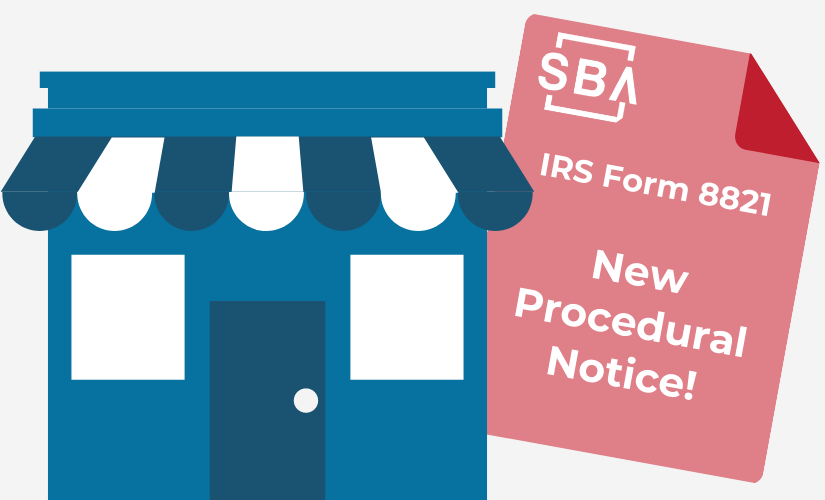What Do SBA Lenders Need to Know About the IRS Form 8821? Published March 28, 2022
SBA lenders—if you’ve ever embarked on completing the IRS Form 4506-C with a borrower, you’ve probably found yourself wishing there was a faster way to receive tax return transcripts and tax compliance data. Perhaps you found yourself unsure if any tax-related financial verification procedures other than Form 4506-C were accepted by the SBA? Either way, don’t worry: we’re here with good news!
SBA Releases IRS Information Verification Guidelines for Form 8821
We’re excited to share that the SBA recently issued SBA Procedural Notice 5000-829416 (effective March 9, 2022) that provides clear guidance regarding the allowance of both the IRS Form 8821 and Form 4506-C to request tax return transcripts and tax data for your SBA’s 7(a) and 504 loan programs. In case you’re unfamiliar with IRS Form 8821, it isn’t a new IRS transcript request form —it’s a decades-old tax information authorization form that helps transform the process of acquiring information from the IRS. Form 8821 is your portal to a faster, easier, more thorough credit underwriting process.
The Neverending Form 4506-C Nightmare
If you’ve filed Form 4506-C before, you’re probably familiar with the painful process of waiting weeks or longer to receive limited financial information or worse, an outright form rejection without any explanation. This is compounded by the fact that the processing slowdown with the IRS’ Income Verification Express Service (IVES) system doesn’t show signs of abating anytime soon. But there’s a better way – utilizing Form 8821 and working with Tax Guard’s team of experts can get you tax return transcripts in as little as four hours. Seriously.
What Does the IRS Form 8821 Mean for SBA Lenders?
An increase in speed isn’t the only advantage to Form 8821. It also increases the breadth and depth of the financial information lenders receive from the IRS. Powered by Form 8821, Tax Guard’s signature report provides information on your borrower’s federal tax compliance over the past ten years or more, including all applicable 1120, 1120-S, 1065, 1040, 940, and 941 returns (and more). We also provide tax return transcripts for all SBA required years and all required income tax forms. Contrastly, when working with Form 4506-C to acquire tax return transcripts, a borrower’s federal tax compliance information is not available to help lenders better assess a loan applicant’s creditworthiness.
Also, lenders or vendors using Form 4506-C can expect to see a 30-40% rejection rate, and to add to the headache, this often occurs without any explanation given. Leaving lenders in the lurch with a poor customer experience and small businesses – many of whom are in desperate need of a loan – delayed by weeks or even months.
The tax compliance data our customers receive from Form 8821 and our Tax Guard report goes far and beyond identifying federal tax liens (which the IRS only officially files 80% of the time a business has tax debt), it includes missing return filing status and payment agreement compliance information, as well as payroll tax deposit records.
Form 8821 has been central to Tax Guard’s process since we started out over 12 years ago. We’re proud to have a successful track record of helping all types of lenders utilize Form 8821 to create efficiencies for themselves and their borrowers in their underwriting process. Additionally, our expertise with Form 8821 and IRS tax compliance data can help our customers with credit risk mitigation too.
We analyzed more than a decade of SBA and IRS loan-level data, we found that:
- When IRS tax debts are identified prior to SBA loan approval, those loans are 37% more likely to charge off.
- When IRS tax debts are identified within a two-year period post-SBA loan approval, those loans are 130% more likely to charge off.
But don’t just take our word for it, we’ve worked with the nation’s top SBA lenders, including Byline Bank and First Home Bank, empowering results such as faster closings and reduced reductions, saving lenders time and money.
This procedural notice will enable the SBA lending community to play a key role in getting small businesses back on their feet after years of upheaval. Let’s help the economy thrive again.
At the end of the day, we aren’t just providing our customers with data—we’re dedicated to providing revelatory information when needed most, and we look forward to continuing to deliver innovative solutions that benefit small businesses and lenders alike for years to come.

